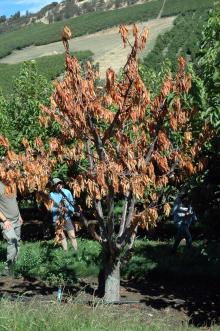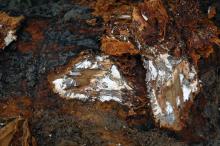Cause Armillaria mellea, a fungus, infects tree roots, killing the cambium and decaying the underlying xylem. Often found on newly cleared land but also commercial orchards, this root pathogen is native to the Pacific Northwest where it occurs on the roots of many woody perennials including native trees and agricultural hosts.
This fungus may form mushrooms at the base of infected trees in fall and winter. Mushrooms produce wind-blown spores, but these spores are not a significant means of infecting healthy trees. The fungus spreads vegetatively, below ground, which leads to the formation of groups of dead and dying plants called "disease centers." The fungus can survive on woody host roots long after the host dies. Its vegetative fungal tissue (mycelium) decomposes root wood for nutrients as it grows. When infected plants are removed, infected roots that remain below ground serve as a source of inoculum for trees planted in the same location.
Infection occurs when cherry roots come in direct contact with partially decayed tree roots and are colonized by mycelium. Infection can also occur when tree roots contact rhizomorphs (black, shoestring-like fungal structures) that grow out from partially decayed roots and through the soil. Once tree roots are infected, whether they are living or dead, they serve as a source of inoculum for neighboring trees.
Resistant rootstocks have been found in Prunus but none have been graft compatible with cherry scions.
Symptoms Trees may show poor terminal growth and undersized leaves. Trees will appear healthy but then suddenly collapse during summer. Dead leaves often will remain attached to dead branches. Diagnostic mycelial fans can be observed beneath the bark of the root crown of infected plants. Dig down about a foot below the soil line and use a pocketknife to remove thin layers of bark from the root collar. Mycelial fans are thick, white layers of fungus that adhere to the root bark and/or the wood beneath the bark. Signs will be located below the bark at the vascular cambium and not on the outside of the bark. Armillaria also makes black, shoestring-like structures called rhizomorphs, which are occasionally found within the bark and/or extending into surrounding soil. Rhizomorphs may look like roots on the outside but have an entirely different structure when cut open in cross-section.
Cultural control
- When clearing a new site of forest trees and shrubs or when clearing a site with infected plants (infection centers) there are several precautions to take.
- Girdle large trees before removal to hasten decay of roots.
- After removing aboveground vegetation, clear soil of stumps and large roots. Deep-rip the soil in more than one direction to bring large roots to the soil surface. If possible, remove all roots greater than 1 inch in diameter from the soil.
- Burn all woody debris.
- Leave this ground fallow at least 1 year.
- Trenches lined with plastic sheeting may help if inoculum is from an adjacent stand.
- If using drip irrigation, move drip-line emitters away from the trunk and in between trees after first year of planting.
- Permanently removing soil in a 3-ft radius around the crown and main trunk root area has been effective in citrus and other tree fruits grown in California and Australia and may be of benefit for managing infected trees in the Pacific Northwest. Also excavate root collars of healthy-looking trees surrounding disease centers. Be sure to keep root collars free of soil, especially in orchards with high gopher populations. Another twist of this idea was used to protect peach trees at planting in the Southeast United States by planting on raised hills or "Smart pots." The soil is removed once the trees have been established, which exposes the root crown.
- Remove and destroy severely infected trees, being careful to remove as much root material as possible from soil. If practical, do not replant where infected trees have been removed.
- In gardens, replant with resistant fruit species such as fig or pear (see the table "Plants Resistant or Susceptible to Armillaria Root Rot," in Section 3).
References Hood, I.A., Redfern, D.B., and Kile, G.A. 1991. Armillaria in Planted Hosts. In: C.G. Shaw, III, and G.A. Kile (eds.). Armillaria Root Disease. Washington, D.C.: United States Department of Agriculture Forest Service Agriculture Handbook No. 961. p 122-149.
Munnecke, D.E., Kolbezen, M.J., Wilbur, W.D., and Ohr, D.H. 1981. Interactions involved in controlling Armillaria mellea. Plant Disease 65:384-389.
Miller, S. B., Gasic, K., Reighard, G. L., Henderson, W. G., Rollins, P. A., Vassalos, M., and Schnabel, G. 2020. Preventative Root-Collar Excavation Reduces Peach Tree Mortality Caused By Armillaria Root Rot On Replant Sites. Plant Disease 104:1274-1279.




